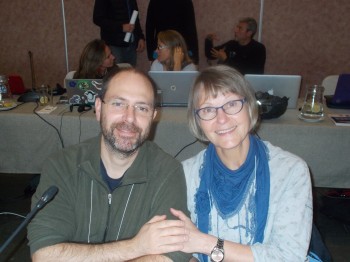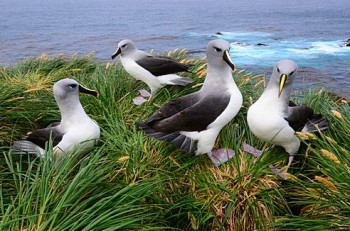On behalf of a group of Australian and Chilean marine ornithologists Javier Arata reported this week to the Third Meeting of ACAP's Population and Conservation Status Working Group (PaCSWG3) in La Serena, Chile on a recent survey of Black-browed Thalassarche melanophris and Grey-headed T. chrysostoma Albatrosses on the Diego Ramirez Islands.

Report co-authors Javier Arata from Chile and Barbara Wienecke from Australia at PaCSWG3
Photograph by John Cooper

Grey-headed Albatrosses on Diego Ramirez, photograph by Graham Robertson
The report’s summary follows:
“Black-browed albatrosses are killed incidentally in commercial fishing operations. Aerial surveys in 2002 and 2011 revealed the number of black-browed albatrosses at the Diego Ramirez and Ildefonso islands, Chile, increased by 52% and 18%, respectively. The increases were attributed to reduced mortality in the longline fishery for Patagonian toothfish following fleet conversion to a new gear configuration with much higher average hook sink rates. A new survey in 2014 revealed the number of black-browed albatrosses at Ildefonso was about the same as in 2011, but the number at Diego Ramirez had increased by a further 29% (8.8%/year). The number of grey-headed albatrosses at Diego Ramirez also increased, by 23%, in the same time period. In 2014 Ildefonso held an estimated 54,284 breeding pairs of black-browed albatrosses. The populations of black-browed albatrosses at two more northern sites, the Evangelistas and Leonard islets, stood at 4,818 and 545 breeding pairs, respectively. The number of breeding pairs of both albatross species at Diego Ramirez could not be determined because not all islands in the archipelago were surveyed.”
Reference:
Robertson, G., Wienecke, B., Suazo, C.G., Lawton, K., Arata, J.A. & Moreno, C. 2016. Continued increase in the number of Black-browed Albatrosses at Diego Ramirez, Chile. Third Meeting of the Population and Conservation Status Working Group, La Serena, Chile, 5 – 6 May 2016. PaCSWG3 Inf 12 Rev 1. 14 pp.
[Note that the report is password protected].
John Cooper, ACAP Information Officer, 06 May 2016

 English
English  Français
Français  Español
Español